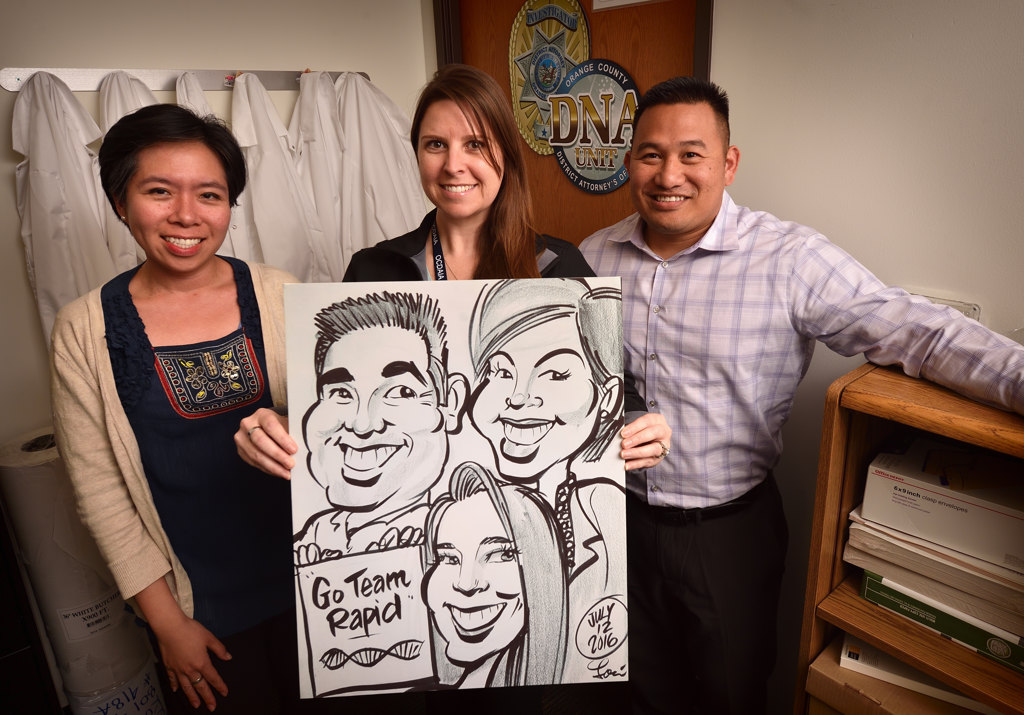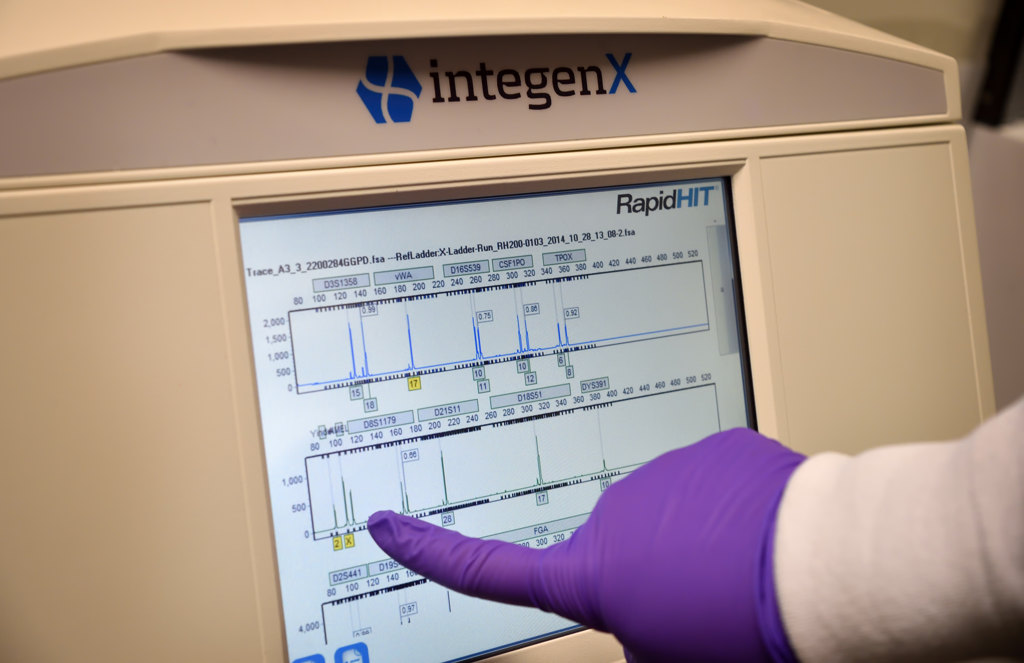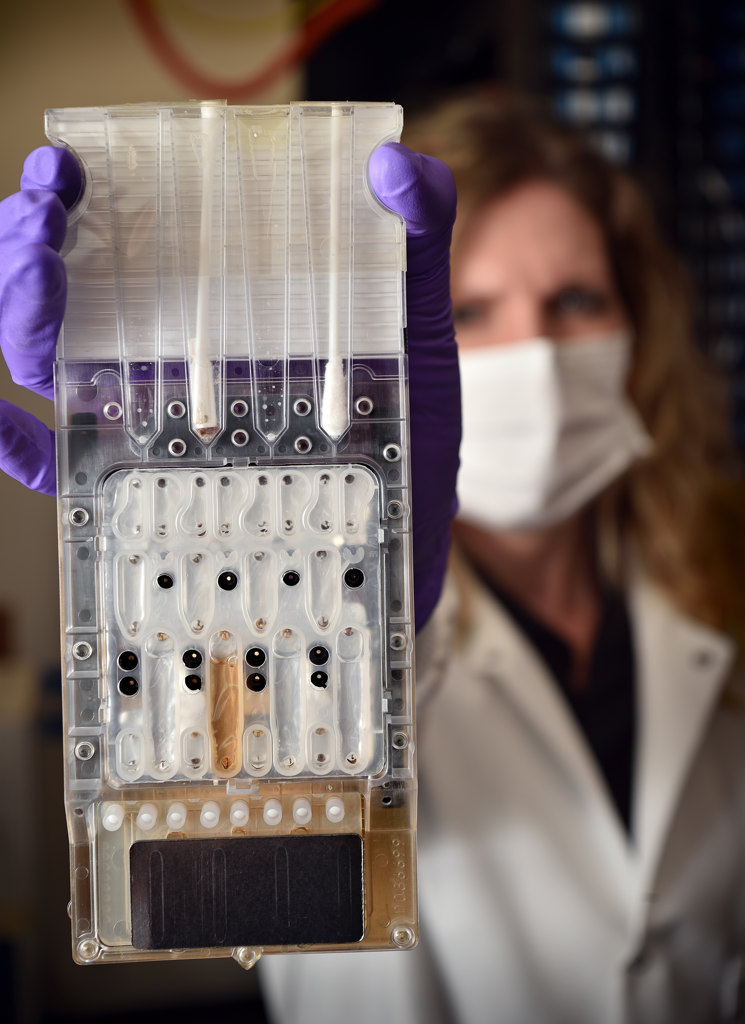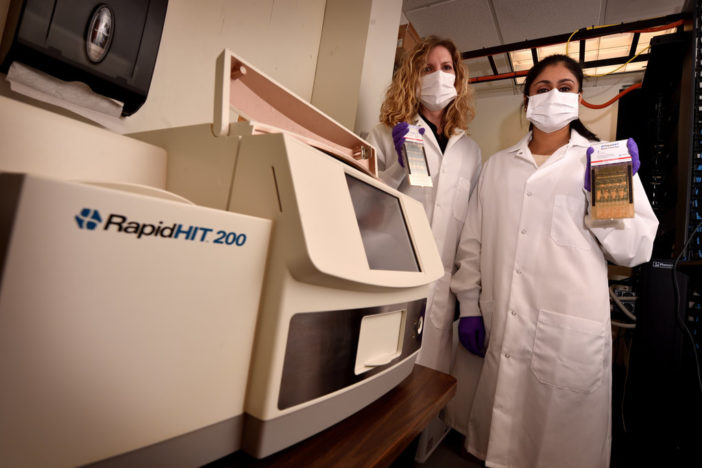The bad guy blew it.
After he cut his hand smashing the window of a car he was burglarizing in November 2016 in Garden Grove, the criminal used 10 napkins he found in the victim’s vehicle to stem the bleeding.
And he left the napkins in the car.
GGPD Det. Dennis Wardle had the bloody evidence processed for DNA.
Thanks to a relatively new program housed in the Orange County District Attorney’s Office, it didn’t take months — or even weeks — for a hit to come back on the DNA.
It took a few hours.
The Garden Grove DNA hit led to three vehicular burglary cases being solved and to the incarceration of the miscreant who admitted to committing the crimes.
Since the OCDA launched its Rapid DNA Pilot Program in October 2014 with five O.C. agencies, its work has led to over a hundred of similar cases being tested — many within hours, with suspects identified through DNA found at crime scenes.

From left, Garden Grove PD Lt. Bob Bouge; GGPD Sgt. Ray Bex; Jody Hynds, a forensic scientist in the OCDA’s DNA Unit; GGPD Det. Pete Garcia; Assistant District Attorney Jennifer Contini of the OCDA; GGPD Det. Dennis Wardle; and Paul Carvo, a supervising investigator in the OCDA’s DNA Unit. Photo by Steven Georges/Behind the Badge OC
Those suspects are among the nearly 153,000 names (and climbing, at a rate of about 1,500 a month) in a database of Orange County residents who have been convicted of crimes, including misdemeanors. In all misdemeanor cases, O.C. prosecutors try to make DNA collection a term of case disposition.
In less than 2 ½ years since the launch of the Rapid DNA Program, something that once was believed to be unthinkable regularly is playing out in the Orange County criminal justice system:
Real life is catching up to TV.
“We are approaching the ‘CSI’ level,” said Jody Hynds, one of the OCDA’s two forensic scientists in the DNA Unit.
“You watch a TV show and by the end of the episode, they’ve solved the crime,” Hynds said. “We’ve almost gotten that fast now. It’s crazy.”
SUCCESS WITH GGPD
Of the 26 O.C. law enforcement agencies that now submit samples to the OCDA’s Rapid DNA Program, no agency has had more hits than the Garden Grove PD, with 11. In terms of the number of submissions made, the GGPD is No. 2, with 34 samples as of March 21, 2017, behind the Anaheim PD, with 36 samples submitted for testing.
The OC Crime Lab is a full-service, internationally accredited laboratory that provides forensic analyses to all law enforcement and fire protection agencies in Orange County.
The OCDA Rapid DNA team works as a complement to the OC Crime Lab, where a DNA sample can take months to complete because of the massive volume of work the lab processes out of its modern 100,000-sq.-ft. facility in Santa Ana.

Angela Lin, investigative assistant, Orange County District Attorney’s Office, left; with Erin Deppe, an investigative assistant and Orange County deputy district attorney, Bureau of Investigation; and Robert Kosi, investigative assistant with the Orange County District Attorney’s Office.
Photo by Steven Georges/Behind the Badge OC
About a decade ago, Orange County District Attorney Tony Rackauckas made a push to develop a local database of profiles from individuals who agreed to provide their DNA samples as part of the disposition of their misdemeanor cases.
Using funds from Prop. 69, the state initiative approved by voters in 2004 that required the collection of DNA samples from all felons, as well as from adults and juveniles arrested for or charged with certain crimes, the OCDA purchased a machine that allows for the rapid processing of DNA samples.
That machine — the RapidHIT™ 200, made by IntegenX Inc. of Pleasanton — is the size of a typical copier.
Housed in a secure, climate-controlled server room in an OCDA office in Santa Ana, the 200-pound machine can generate five standardized DNA profiles from a disposable cartridge containing buccal (cheek) swabs, blood, cigarette butts, gum, and semen not mixed with another agent.
A large amount of DNA is needed for the RapidHIT™ 200 to obtain a profile — say, a stain of blood the size of a pea or eraser head. The machine cannot, for example, detect “touch” DNA or minute samples of DNA that experts in the OC Crime Lab can identify.
When law enforcement agencies collect DNA from a crime scene, they submit half to the OC Crime Lab and the other half to the OCDA’s Rapid DNA unit. OCDA coordination with the OC Crime Lab allows the lab to prioritize evidence testing for court. The OCDA conducts rapid DNA tests samples to generate investigative leads.
The RapidHIT™200 develops a DNA profile the same way the OC Crime lab does. It’s not new technology — the PCR method, or Polymerase Chain Reaction, has been routinely used for forensic testing for over 15 years.
But the machine dramatically saves time by shrinking down the processes used by the OC Crime Lab into a single box, eliminating the need for several pieces of equipment and forensic specialists housed in different rooms.

Jody Hynds, a forensic scientist with the OCDA’s DNU Unit, point to results of a blood sample run through the the RapidHIT™ 200. Photo by Steven Georges/Behind the Badge OC
“We’re now solving cases in a matter of hours,” says Paul Carvo, a former Tustin PD officer who is a supervising investigator in the OCDA’s DNA Unit.
Carvo works alongside Assistant District Attorney Jennifer Contini, the supervising attorney of the DNA Unit, as well as another supervising investigator who is in charge of all of the OCDA’s database collection sites.
“It’s unbelievable,” Carvo said.
SMOKER’S REGRET
All Garden Grove PD officers are trained in the collection of DNA from crime scenes, in addition to the agency’s CSOs (community service officers).
“In the past, sometimes it would take six months to a year to get a DNA hit back,” Wardle said.
Such a delay would allow a suspect or suspects to remain free and continue victimizing people, Wardle said.
Thanks to the Rapid DNA Program, Wardle and fellow GGPD Det. Pete Garcia, as well as other GGPD detectives, have been able to nab suspects within hours.
One of the agency’s first successes came in December 2015, after a suspect in a car burglary left behind a cigarette butt.
The crime occurred Nov. 30, and the butt was delivered to the OCDA’s office around 8 a.m. Dec. 1.
By noon that day, Carvo called the GGPD with a name that turned out to be a known offender to GGPD officers. The suspect, William Avalos, was arrested the same day.
The OCDA filed charges against Avalos, who had an active warrant and was on probation when he was arrested, on Dec. 18. He pled guilty on Dec. 29.
So within a month of when the crime had occurred, the case was closed — thanks to the OCDA’s Rapid DNA Program.
Contini said that from a prosecutor’s perspective, the program is valuable because witnesses have a better chance of identifying a suspect from a “six pack” of photos because their memories are fresh. And in many cases, she said, the culprit still is in possession of stolen property — meaning the victims get it back.

Two buccal (cheek) swabs are seen at the top of a disposable cartridge that is inserted in the RapidHIT™ 200 machine at the OCDA office in Santa Ana. Photo by Steven Georges/Behind the Badge OC
“This (Rapid DNA Program) makes getting corroborating evidence a lot easier,” Contini added.
The OCDA is one of only three or four agencies in the country with a rapid DNA program, Contini said.
Unique to the OCDA, however, is the fact that two forensic scientists — Hynds and Anna Dadhania — review the profiles generated by the instrument. They are better able to review profiles and search the database than law enforcement officers with limited training.
To ensure a system of checks and balances, Hynds and Dadhania never handle the evidence. Three investigative assistants perform that task.
To date, 60 percent of GGPD submissions to the OCDA Rapid DNA Program have been cigarette butts, followed by blood samples at 37 percent and gum at 3 percent, said Hynds.
Of all the samples the GGPD has submitted, the OCDA Rapid DNA team has been able to obtain searchable profiles 77 percent of the time and get hits on those profiles 48 percent of the time.
“They’re collecting really good DNA samples,” Hynds said of the GGPD.
OTHER SUCCESS
Several O.C. law enforcement agencies have had great success through the rapid processing of DNA.
On March 31, 2016, a home in Cypress was broken into. The suspect, alas, left behind a cigarette butt. The butt was submitted to the OCDA and a hit was obtained the next day, April 1.
Cypress PD officers were familiar with the suspect and knew his girlfriend. They went to her house on April 2 and found her trying to sell the stolen property on Craigslist.
Both she and the suspect were found in possession of $5,200 worth of construction tools that had been stolen from a man who couldn’t work without them. The victim recovered his property and the suspects pleaded guilty within a week.
The Orange PD also had a hit following a robbery of a Del Taco on Thursday, Jan. 26, 2016.
Around 9:30 p.m. that night, a car containing four people pulled up at the drive-through. The occupants ordered drinks and then parked. Two of the occupants then bolted into the Del Taco wearing hoodies and robbed the place at knifepoint, making off with the tray in the cash register. The drive-through clerk was so frightened she escaped out the drive-through window.
In what appears to be a common blunder, one of the suspects left behind a cigarette butt inside the Del Taco.
Orange PD Det. Dave Pasino got the case the following Monday, Jan. 30.
On Feb. 1, the OCDA DNA Unit got a hit on the DNA on the cigarette butt. It matched the DNA of the primary suspect, who lives in Placentia. He was arrested and implicated himself in the crime, Pasino said. The second suspect remains at large.
“It’s very efficient and very quick,” Pasino said of the Rapid DNA Program. “It’s really invaluable. I’m hoping this kind of technology takes over. The best part of it is, we’re able to go after repeat offenders.”
There have been no homicide or violent crime hits generated through the OCDA Rapid DNA Program, but the team has assisted other agencies in such investigations.
In one example, the Orange PD developed two homicide suspects from surveillance video. One suspect left blood on a wall.
The Orange PD got the suspects to voluntarily submit to buccal swabs. While they were interviewing the suspects, Carvo called the detectives and told them which suspect’s blood was on the wall.
The OCDA DNA Unit also helped the Irvine PD following a homicide. Carvo was able to tell the IPD that blood found on a paved bike trail following a stabbing was that of the victim and not a suspect.
Garden Grove PD Lt. Bob Bogue, a 29-year veteran of the agency, recalls the old days when officers responding to crime scenes hoped to obtain a good fingerprint or two.
“Back then,” Bogue said, “DNA was just a dream.”
Now it’s reality. And the speed at which hits are being obtained is increasing — which is great news for law enforcement, but not so great for the bad guys.
“This is kind of a proof of concept program,” Contini said. “People thought this would never be possible, but with the power of the local OCDA DNA Database combined with the Rapid program, we know we can do this. Now the challenge is to do this on a large scale to expand its potential to increase public safety.”
 Behind the Badge
Behind the Badge



